[EDIT: you can read the stories from my progress across my map here.]
Making my way through autumn leaves to a village that I only know as a motorway junction, a giant snarl of a roundabout, some boring industrial warehouses. And yet today I come to it down narrow lanes fringed with golden leaves, the trees blowing and leaves spinning and spiralling in the wind, past harvested stubble fields and grassy horse pastures. It’s disorientating – I’ve never been this way before, nor thought of this place in this way. It’s made me curious for what I might discover, on this my last day of a year of exploring 52 grid squares on my local map. One year on a single map and I am nowhere close to knowing it fully.
I feel sad that the project is ending, though of course there’s no need for it to end. This forced curiosity can continue for ever. I can never know even this one map, not in all its seasons and weathers and times of day, not all its harvests or nature, and I have not even begun on the countless human stories intertwined on this one seemingly nondescript map. Like a fractal, you can see the minute or the universal everywhere, depending on how you look. Serendipitous then that I walked past a house called Galleon’s Lap (opposite a home with two gigantic gnomes –surely an oxymoron– and a Lego dinosaur in the front window). Googling the curious name I discovered that it comes from The House at Pooh Corner where ‘they walked on, thinking of This and That, and by-and-by they came to an enchanted place on the very top of the Forest called Galleons Lap, which is sixty-something trees in a circle; and Christopher Robin knew that it was enchanted because nobody had ever been able to count whether it was sixty-three or sixty-four, not even when he tied a piece of string round each tree after he had counted it. Being enchanted, its floor was not like the floor the Forest, gorse and bracken and heather, but close-set grass, quiet and smooth and green. It was the only place in the Forest where you could sit down carelessly, without getting up again almost at once and looking for some where else. Sitting there they could see the whole world spread out until it reached the sky, and whatever there was all the world over was with them in Galleons Lap.’
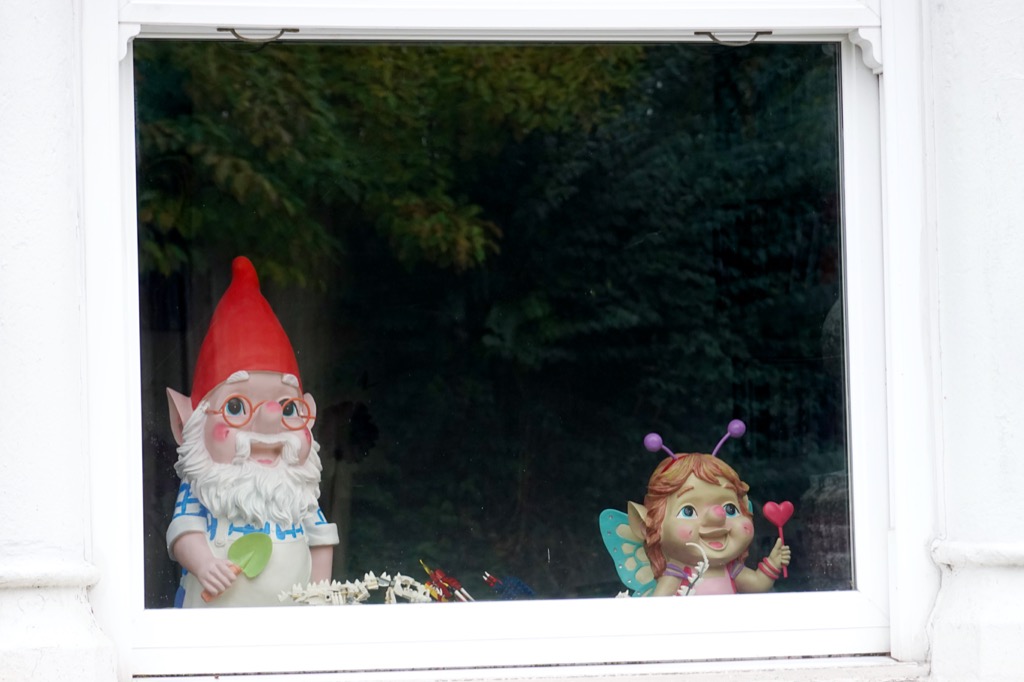
Although this is due to be my final grid square, I choose not to dive into a rabbit hole of reminiscence and reflection. There’ll be time enough for all that later on. As I took out my camera I did allow myself to wonder how many photographs I have taken this year (8898, it turns out, of which 1266 made it into my Flickr Album for the project). Having a reason to commit to taking photographs regularly has been one of my favourite aspects of this project, and has certainly heavily influenced the way I explored and observed my map. Photography is the art of observation, of recording people, places and moments in time. As iconic French photographer Elliott Erwitt said: “To me, photography is an art of observation. It’s about finding something interesting in an ordinary place… I’ve found it has little to do with the things you see and everything to do with the way you see them.”
Each time that I arrive in the grid square I’ve chosen I then look at the detailed map on my phone and begin to orientate myself, interpret what I see and figure out the lay of the land. Today’s square felt tricky to navigate, with footpaths, roads and a train track spidering across the one kilometre square. I didn’t allow myself to choose a “good” square for this final one. Instead I picked it fairly random, as usual, looking only to spread out all the way across the map. So I didn’t expect very much from it, and yet once again I was surprised, interested and charmed by what I found along the way.
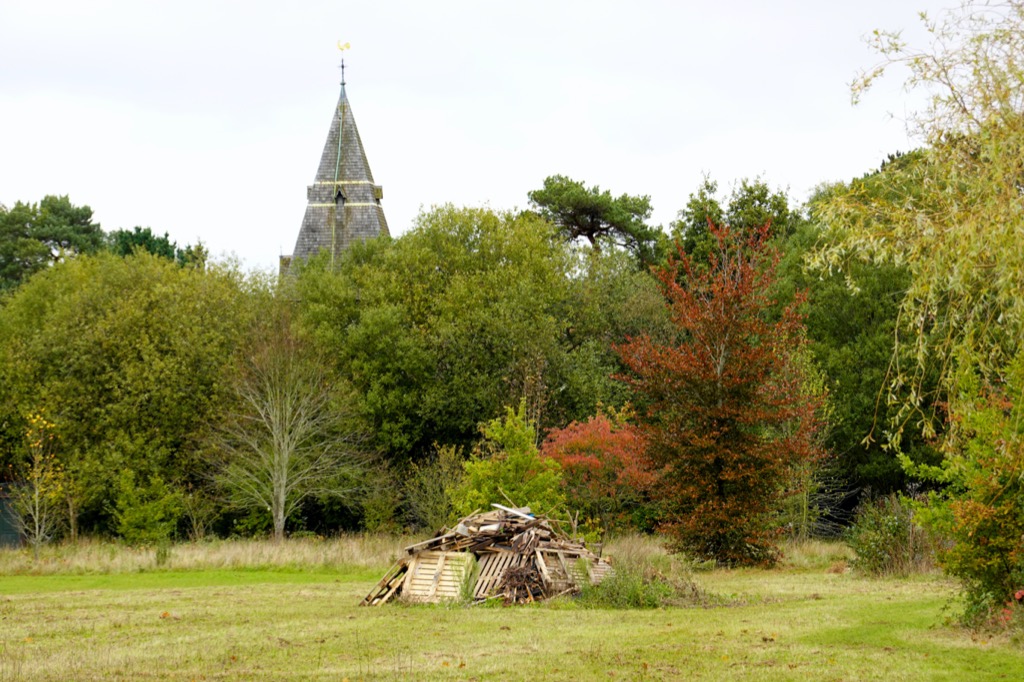

Paths felt like they were tunnelled through hedges, branching off like streams, as I made my way to the church. Parakeet screeches rang out from the church’s yew trees, an increasingly common bird call around here, but not one that I like yet.
Their bright green feathers and unmistakable squawk make ring-necked parakeets a striking addition to British park wildlife, but the question of how the tropical birds were first introduced has been a subject of contention. One urban legend traces their origin to a pair released by Jimi Hendrix on Carnaby Street in 1968; another suggests they arrived in 1951 when Humphrey Bogart and Katharine Hepburn visited London with various animals in tow to film The African Queen, set in the equatorial swamps of east Africa.
Now the question has been subjected to a rigorous forensic analysis for the first time, in research that points to an entirely different explanation: pet owners around the country releasing the birds into the wild, possibly prompted by media coverage of fatal “parrot fever” outbreaks. Analysis based on geographic profiling methods used to track down criminals concluded that Britain’s booming parakeet population has grown from numerous small-scale accidental and intentional pet releases.
The analysis tested other popular theories, including that parakeets kept at Syon Park in west London escaped in the 1970s when debris from a plane crashed through the aviary roof, or that damage to aviaries during the Great Storm of 1987 was responsible. However, none of the suspect sites showed up prominently in the heatmap of more than 5,000 unique records dating from 1968 to 2018.
Media coverage occasionally suggests that a cull of ring-necked parakeets may be necessary, due to their rapidly expanding numbers and concerns about their potential impact on native bird species such as woodpeckers, starlings and nuthatches, through competition for nest holes. The RSPB is not in favour of a cull of parakeets at this time, but believes it is important that the spread of the ring-necked parakeet is monitored and its potential for negative impacts on our native bird species assessed. The government is obliged to ensure that non-native species do not adversely affect native wildlife and has developed a policy framework for addressing the possible risks associated with such species becoming established.
“Squawk!” Screeched the parakeets, before flying off in a small group at their typically high speed. “Squawk! We are here because you were there!” We went to their country, messed about, brought the birds home because it suited us, and then they settled, thrived and live here. What right does that then give me to chunter about their presence and my haphazard, lop-sided, shifted baseline perceptions of what ought to belong in ‘my’ country? Very little.
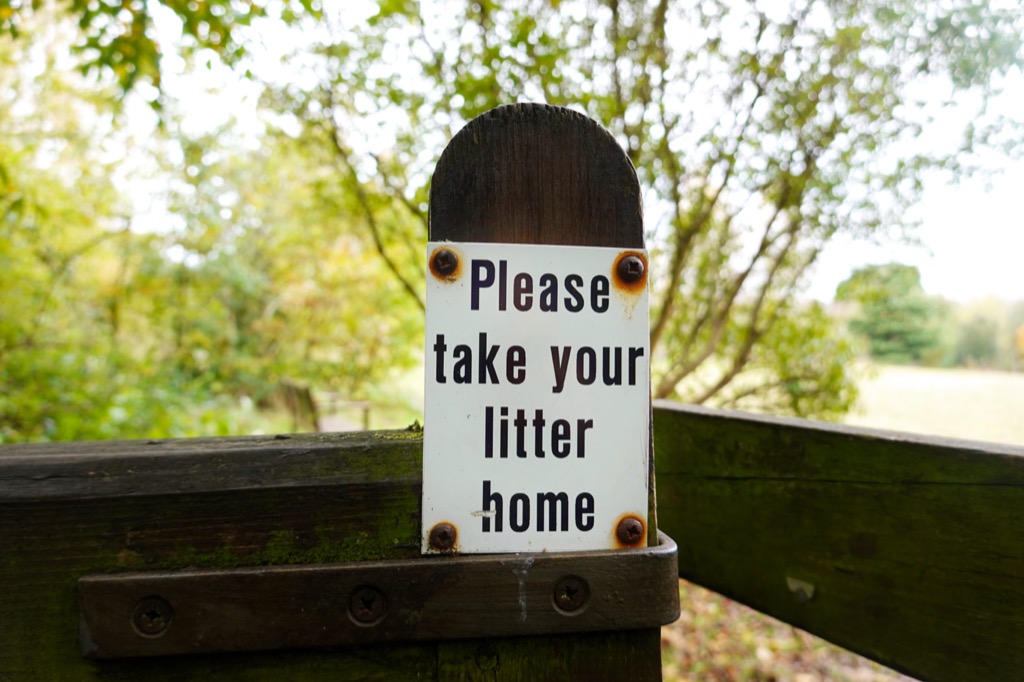

The church was locked so I meandered around the graveyard for a while. I was drawn towards one grave that was festooned with bright plastic flowers and red heart-shaped helium balloons. A large photograph showed a young lad posing in silk boxing shorts with his fists up in a guard position. Google quickly led me to the sad story of a keen young boxer from the Traveller community whose final fight was with bone cancer. Traditionally for people from the Romany community photographs of the deceased would be buried with them, however, this has changed over time and photographs are now often placed on the graves for both the Romany and Irish Traveller community’s. They enable the family to connect with the spirit of loved ones but also as a community, many of whom are non-literate, it is a way of identifying the graves of family members or people from the community that they knew.
Many of the wreaths that are laid show the theme of Travelling such as a floral lorry however many also show the theme of being rested and seated. The floral chair which is called the ‘vacant chair’ is made of white or red flowers and allow the deceased to finally rest. Some keep a ‘vacant chair’ in their homes and this represents the connection that the living have with the deceased. A floral pillow is also made for the deceased to rest their head. Hearts are also common and represent the family giving their hearts to the deceased. Floral decorations of wagons, horses, trailers, horse shoes, dogs, birds and other objects that represent the deceased are also made, allowing family to connect with their loved one.
Click led on to click and I found myself, 15 minutes later, still scrolling sadly through a tribute Instagram page filled with smiling photos from his life and stoic thumbs’-up images from hospital beds. I sighed sadly, put away my phone, and cycled away.
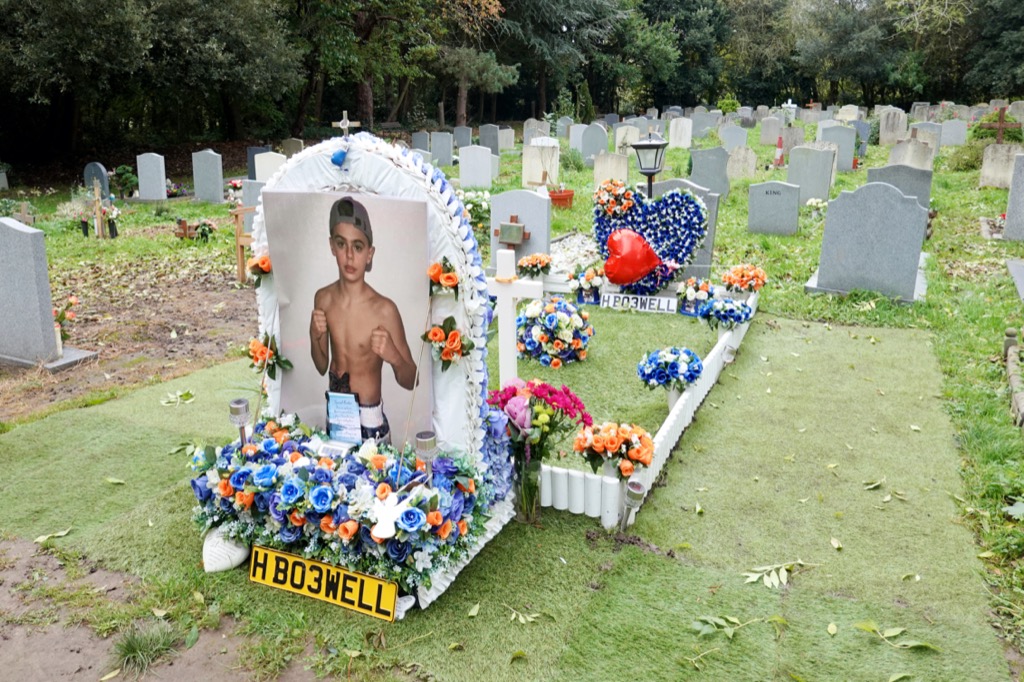
The footpath led to open fields, separated by hedges or fences and stocked with horses grazing quietly. The trees were still mostly green, though turning now to autumn colours. Autumn is much later than I always assumed. There were long views under grey skies across low, undulating land, sprinkled with modern housing developments, pylons and fields. It felt satisfying to look around and notice how places fitted together “OK, so there’s that big bridge… Oh yeah, there’s the huge pylon. I see where I am now.”
Dogs barked in the distance and the sound of kids playing carried through the air. The motorway was surprisingly quiet, though continuously audible. The school bell rang, summoning the children away from play and back to work.
I used the Seek app on my phone to identify the bright pink fruits of the Spindle: industrious, delicate, colourful. The spindle is at its loveliest in autumn when its leaves turn russet and its pink and orange fruits ripen. Wildlife loves its leaves and fruit, and aphids flock to it, bringing with them an array of their predators. After pollination, flowers develop into bright pink fruits with bright orange seeds, which look a bit like popcorn. Spindle is an ancient-woodland indicator. If you spot it while you’re out exploring, it could be a sign you’re standing in a rare and special habitat.
Spindle timber is creamy-white, hard and dense. In the past it was used to make ‘spindles’ for spinning and holding wool (hence its name), as well as skewers, toothpicks, pegs and knitting needles. The fruits were baked and powdered, and used to treat head lice or mange in cattle. Both the leaves and fruit are toxic to hum ans – the berries having a laxative effect. Today, spindle timber is used to make high-quality charcoal for artists.
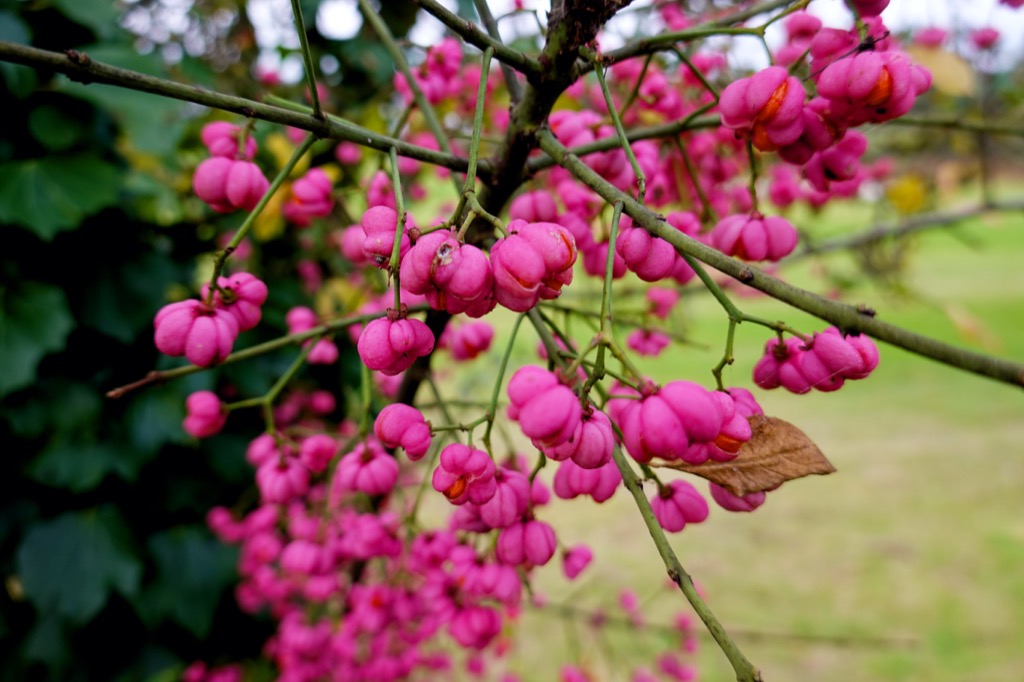

I followed the footpath through several horse paddocks towards the road. A workman was digging the driveway at a small oil analysis laboratory and stopped as I walked past him on the footpath. He climbed down, clearly eager for a chat, and told me all about the new driveway. He then asked, “where does the path go up there? I’ve never been.”
“You should go and explore,” I suggested.
“I might just do that.” he replied, and I went on my way, my day’s work already done.
Pedalling along the lane I passed a few tiny bungalows not a great deal bigger than the shed where I write. And I also passed an enormous gabled house with spiked fences, a gravel turning circle and a swimming pool. We all live such very different lives, even along the same road on the same grid square on the same little map.
A wren let loose with a burst of its staccato song. My bikes wheels crunched over hundreds of prickly balls of sweet chestnut nuts. I paused on a narrow bridge to watch a train rattle slowly beneath me and peered to look more closely at a small Helicina snail. There are around 120 species scattered across the UK, from the Isles of Scilly to the Highlands of Scotland, including hothouse aliens that are found only in botanic gardens and greenhouses, such as Kaliella barrackporensis in Cornwall’s Eden project. They range in size from the tiny Punctum pygmaeum at 1mm wide, up to the golf-ball sized Helix pomatia, originally introduced to the UK by the Romans.

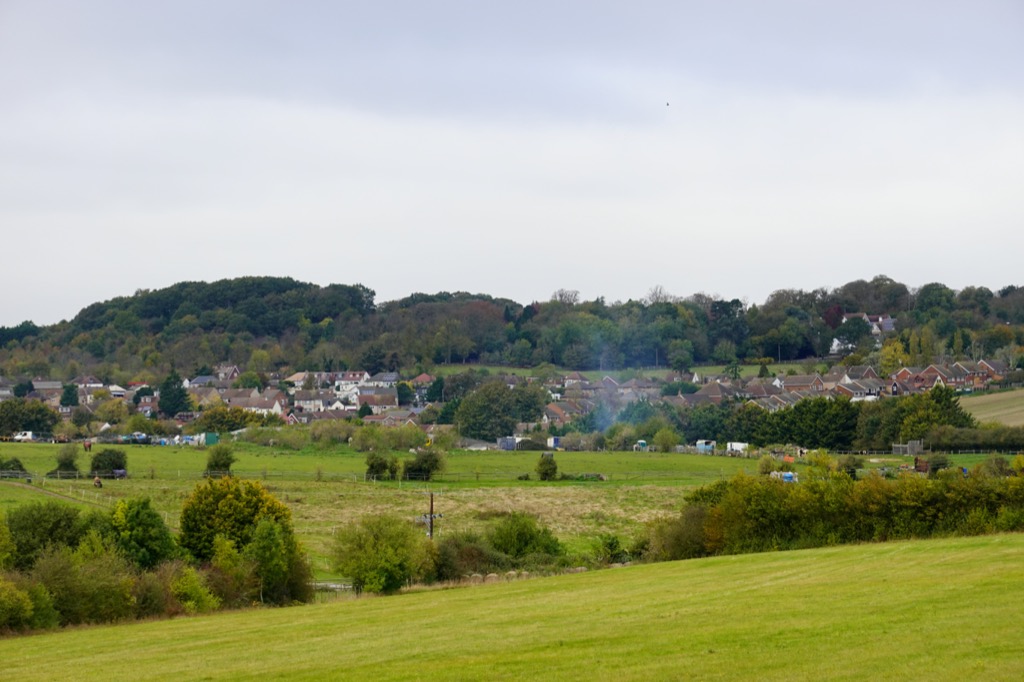
I turn onto another footpath through a brown empty field towards the motorway. There is fly-tipping (of course). The noise of the motorway is growing louder now. For some reason I really like footpaths and fields and woods that lie right up against impersonal, unwelcoming infrastructure like motorways, railways, factories. I don’t know why this is. Perhaps is because they are so at odds with my rural upbringing of. These noisy, semi-feral, liminal edgeland spaces fascinate me.
Someone, at some point, had hurled a vacuum cleaner high up into an oak tree, and there it dangled still, tantalising me with its mystery. Why? How? When? There are a million stories everywhere. Multiply that by the thousands of years’ of people who have walked these paths and fields that I am in today…
I enjoy being close to motorways on foot. I like the size, the noise, the power, the speed, the sense that this place is very much not designed with me – a pink, squashy, slow little pedestrian – in mind. I like crossing them on pedestrian footbridges, and I enjoy the colossal concrete weight of tunnels under motorways. As a bonus the chestnut woods that the tunnel took me to were flush against the motorway, so I could peer through the branches at the lorries hammering past just metres away.

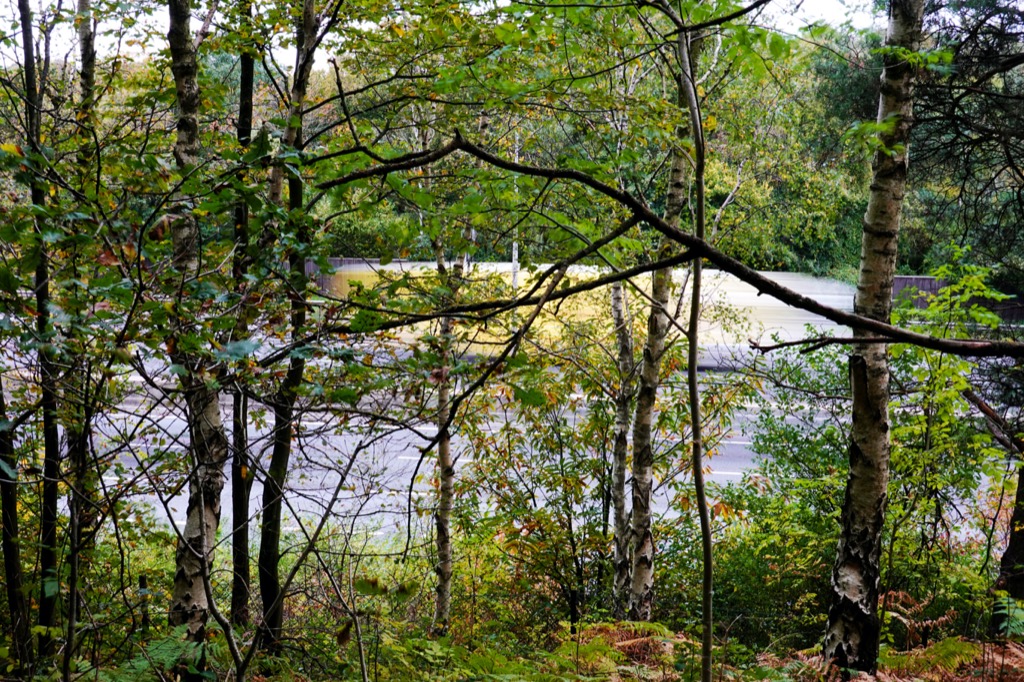
On the other side of the wood were fruit fields covered in polytunnels and a muddy motocross circuit. I looked at the bumps and bends and berms in admiration of the nerves and skill of the riders.

It was a nice wood, despite the motorway’s roar, a mixture of chestnut, oak and birch. I watched a jay fly past with a large chestnut in its beak, its electric blue feathers gleaming even in this dark wood. Years of old ropes, snapped or frayed and out of reach, hung from the limbs of a tall oak tree. The latest swing was a dark blue rope with a thick stick tied to the bottom to hang on to and I had a go, which turned into about ten. The swing was over a steep and muddy slope covered in leaves, a perfect spot for kids to slither up and career down, arms flailing, eyes wide, laughing with enjoyment. I spent a lot of my childhood messing about, unsupervised, in woods like these and I am very grateful for those memories.


I am grateful too for all the memories I have accumulated exploring my map. I will reflect on the whole experience later, no doubt. What began as a stop-gap project to help nurse me through lockdown has grown into a year full of learning of surprises. It has helped me notice the nature in everyday lives, taught me so much about so much, and helped me appreciate the area I have reluctantly found myself living in. It’s been great. And I can’t think of a more apt way to finish off the grid square and the year than by barreling down a twisting, muddy singletrack path I never knew existed on a folding bicycle designed for city life in a surprisingly beautiful little wood strewn with leaves and discarded drinks cans alongside a noisy motorway.
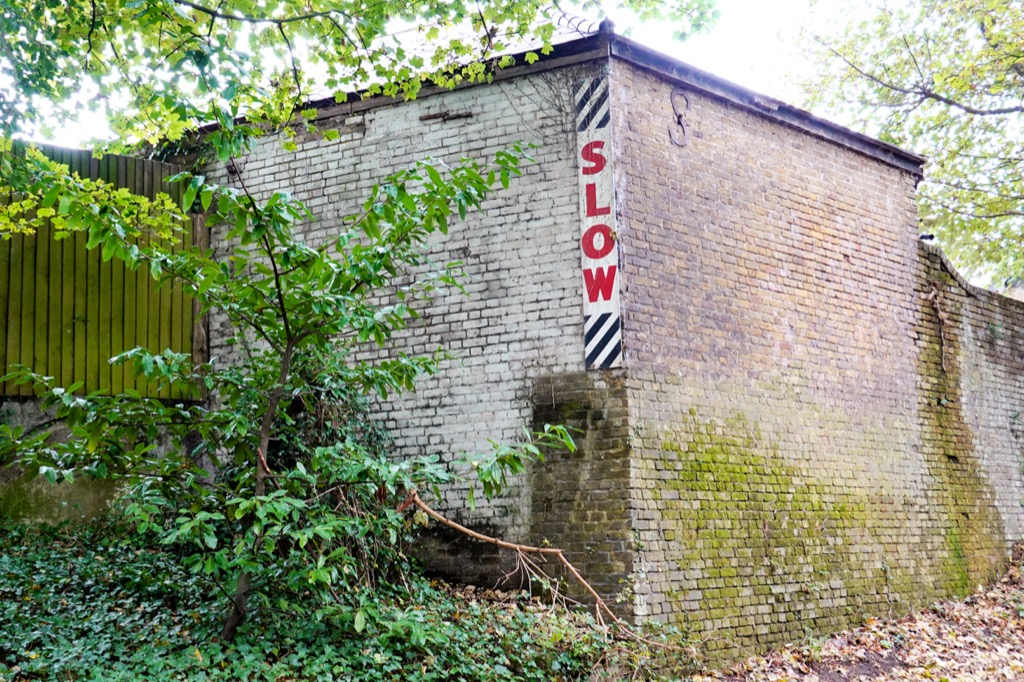



Congratulations on reaching this milestone. I have really enjoyed this series and have started doing something similar (I am using a 25 km circle centered on our home since we back up right onto one of the Great Lakes).
Oh great – I love how everyone’s experience of this idea will be so similar yet so different.
Congratulations! This is such a great project, and everyone who explores should do something similar.
I look forward to buying the book. I hope you have something in there about methodology for all the research you shared about all the things you found.
Thanks Daniel!
Thanks Alastair.
What a wonderful journey to follow you on. It has opened my eyes to what I have yet to explore outside my front door. I particularly enjoyed the photos you would post to accompany each article.
Well done & thanks.
Thanks Drew.